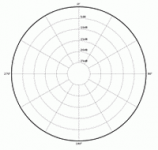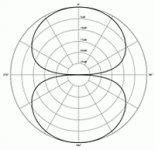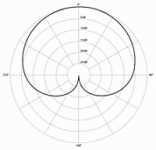Hey, isn't that Elias's idea?
Desparately trying to find the time to do this
www.diyaudio.com/forums/multi-way/222698-ep21-single-stereo-loudspeakers.html
Weather had been so good I had resisted the tempation to cut wood !
I believe a dipole can work but it requires lots of acoustic room treatment to sound really good. I'd prefer a more intelligent speaker/room design.
With dipoles always best to diffuse than absorb , distance from the front wall vs listening distance is very critical ...
What probably works best in a two-speaker configuration is a cardioid toed out. The idea is to create a strong side wall reflection that is spectrally similar to the direct sound. I tried a crude approximation by toeing out two Geddes Nathans and it did work quite well.
Hey! Like a Bose 901 ....

Hey, isn't that Elias's idea?
Not that I'm aware of.
With dipoles always best to diffuse than absorb , distance from the front wall vs listening distance is very critical ...
Hey! Like a Bose 901 ....
Way too much energy that muddies the result. The D/R ratio should be rather high. Nothing you can get from a dipole or Bose 901 without elaborate room treatments.
If you want to go down the simple two-speaker road a cardioid is probably the best choice.
Last edited:
oh yeah? What is the D/R ratio of a monopole at 300hz in a room without "elaborate treatment"?
How do you get directivity down to 100hz? There is still plenty of phase information down there..
Not sure what your point is. I was talking about cardioid not monopole.
By the way, you can get near free field conditions below 100Hz with a DBA or by placing subs very close to the listener.
Dipoles turned side ways = cardioid ....
No, it's not. A dipole with a delayed rear wave is a cardioid.
The "Plutos" aren't real Plutos:
http://www.diyaudio.com/forums/multi-way/204733-linkwitz-pluto-minidsp-classd.html
And the construction of them was in no way based on information contained in the plans, right?
There was a whole thread on the OPLUG about this chap's build. I know exactly what they are and how they came to be.
Dipoles turned side ways = cardioid ....
No.
Monopole:
Dipole:
Cardioid:
Attachments
Is there really a point to this thread? That the Orion had flaws from the get go isn't exactly news. I pointed out several of them when it was first introduce. Some have been addressed over time. Some are inherent in the design (low tweeter x-o point leading to excessive divergence from dipole radiation above the x-o point). I addressed some of the issues in the original NaO design later in the original NaO Note took it further. Today we have the Note II and the LX521 which both follow the original Note concept. The Note II and LX521 both address the flaws on the Orion and are remarkable similar. They are both superior designs to the Orion and would likely fair differently in any comparative tests.
I will add one thing about such test. Regardless of the tests, if the subjects are used to listen to convectional box speakers then even in a blind test it is probably likely that they will have a build in bias (subconscious) to box type speakers because they will recognize the sound as familiar. Since dipoles will typically sound very different it is likely that they would be discounted as they would stand out and under such tests human psychology suggest that this deviation for the generally more familiar sound of a box system (the norm) would trigger a "fault" response.
It's time to move on here. As usual the discussion leads nowhere. Audio is never about perfection though some would like you to believe it is. It's about personal preference. If I like inaccurate, boosted bass or glaring highs who is anybody to tell me I'm wrong?
I will add one thing about such test. Regardless of the tests, if the subjects are used to listen to convectional box speakers then even in a blind test it is probably likely that they will have a build in bias (subconscious) to box type speakers because they will recognize the sound as familiar. Since dipoles will typically sound very different it is likely that they would be discounted as they would stand out and under such tests human psychology suggest that this deviation for the generally more familiar sound of a box system (the norm) would trigger a "fault" response.
It's time to move on here. As usual the discussion leads nowhere. Audio is never about perfection though some would like you to believe it is. It's about personal preference. If I like inaccurate, boosted bass or glaring highs who is anybody to tell me I'm wrong?
Audio is never about perfection though some would like you to believe it is. It's about personal preference.
Reproduction shouldn't have anything to do with personal preference. Do you have a preference how the colors of your TV or projector should be calibrated?
They are both superior designs to the Orion and would likely fair differently in any comparative tests.
So much for "Build your last loudspeakers yourself or let us build them for you"
The problem is not that we should aim for perfection. The problem is that we have pseudo-scientific, unsubstantiated, subjective bias offered by Audiophile Gurus to influence people's purchasing decisions. It's misleading, it's wrong, and does not serve the DIY community's best interest. We may as well believe all the hype we read in Stereophile.
Markus and John k are both right and wrong.
John k thinks that reproduced music is always faulty in some way. It is impossible to sound exactly like natural sound from a singer, instrument or orchestra (in some room/space)
Markus thinks that the reproduction must be truthful to original sound caught by microphones or at least as it is recorded and put on a record (in two channels usually)
What sense is in arguing if we talk about different things?
I was at two live conserts yesterday and the day before. The sound is always different. If you want a record to sound "live", you must also define, which concert hall and which seat, how many people. How are the diffusers, panels and curtains set etc. ..endlessly
John k thinks that reproduced music is always faulty in some way. It is impossible to sound exactly like natural sound from a singer, instrument or orchestra (in some room/space)
Markus thinks that the reproduction must be truthful to original sound caught by microphones or at least as it is recorded and put on a record (in two channels usually)
What sense is in arguing if we talk about different things?
I was at two live conserts yesterday and the day before. The sound is always different. If you want a record to sound "live", you must also define, which concert hall and which seat, how many people. How are the diffusers, panels and curtains set etc. ..endlessly
That's exactly what a dipole does . . .So the trick is to add single strong first reflections while keeping the level of the diffuse sound field low.
That's exactly what a dipole does . . .
And so does a standard box speaker.
That kind of defeats the purpose . . .Although some dipole fans here like to absorb the rear wave as well
No, the "standard box speaker" suffers from an irregular polar response that produces a correspondingly irregular "first reflection".And so does a standard box speaker.
- Home
- Loudspeakers
- Multi-Way
- Linkwitz Orions beaten by Behringer.... what!!?


